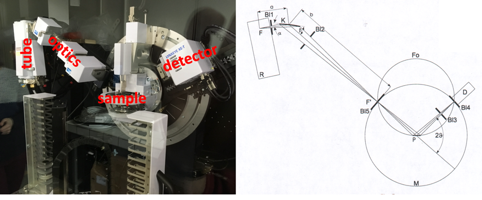ECTS
4 credits
Training structure
Faculty of Science
List of courses
Choice of 2 out of 3
Solution chemistry supplements
2 creditsCrystallography I
2 creditsThermodynamics and phase equilibria
2 credits
Solution chemistry supplements
Study level
BAC +4
ECTS
2 credits
Training structure
Faculty of Science
The aim of this solution chemistry course is to introduce the various concepts needed to study the complex liquid mixtures used in separative chemistry. The proposed approach is mainly thermodynamic. In particular, we explain the role of concentration effects, beyond the ideal laws valid only for dilute solutions.
CM: 12 H
TD: 8 H
Crystallography I
Study level
BAC +4
ECTS
2 credits
Training structure
Faculty of Science

This lecture, entirely provided in English, gives a basic introduction into crystallography and electron diffraction for beginners. X-ray diffraction is an important characterization technique in modern chemistry the majority of crystalline structures in inorganic and organic solids have been solved by this method. It is therefore of importance for all students to have an understanding of its basic concepts and instrumentation. The course provides explanations and principles of X-ray diffraction together with the geometry and symmetry of X-ray patterns. Beside interaction principles of X-rays and matter, it treats how to obtain quantitative intensities for single crystal and powder diffraction patterns. It naturally includes the understanding of lattice planes and the reciprocal lattice concept together with the Ewald sphere construction. Further on it gives a basic understanding of the Fourier transform relation between the crystalline structure and the diffracted intensities as well as the reciprocal lattice concept.
Electron diffraction is a complementary technique to X-rays that provides information in terms of symmetry and geometry on the materials studied. In this course, we will therefore approach the description of the method for obtaining electron diffraction pattern and their interpretation. We will be able to obtain the lattice parameters, the reflection conditions as well as the groups of possible spaces.
This lecture also serves as the introductory part to the lecture Electron Microscopy and Crystallography II
CM:14
TD :6
Thermodynamics and phase equilibria
Study level
BAC +4
ECTS
2 credits
Training structure
Faculty of Science
- Thermodynamics of single-component systems.
- Basic thermodynamics of multicomponent systems. Chemical potential, Gibbs-Duhem relationship, variance.
- Thermal analysis techniques used to construct binary/ternary diagrams: ATG, ATD and DSC
- Construction and interpretation of binary phase diagrams based on thermodynamic quantities. Diagrams of Gibbs free enthalpy, pressure and temperature as a function of binary mixture composition. Liquid-liquid, liquid-vapor, solid-liquid mixtures.
- Phase transformation: first- and second-order transitions, critical points. Examples.
- The supercritical state: definition, thermodynamic properties, wide-ranging industrial applications.
- Construction and interpretation of ternary phase diagrams: variance, definitions of ternary eutectic, first- and second-order peritectic, isothermal section, study of alloy cooling.
Hourly volumes* :
CM :13
TD:7

